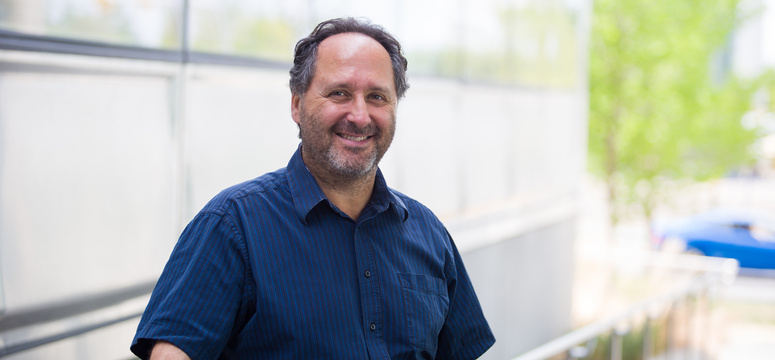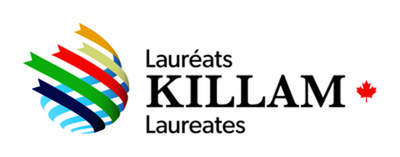This the last of a five-part series profiling the University of Calgary’s 2016 Killam Professors.
When it comes to physics, Barry Sanders has made notable contributions to his field. The professor in the Department of Physics and Astronomy, who is also the AITF iCORE Strategic Chair of Quantum Information Science and director of the Institute for Quantum Science and Technology (IQST), can now add Killam Annual Professor to his long list of professional achievements.
Sanders, however, has no plans to stop adding to that list. The accomplished researcher and educator will be dedicating the next six months to exploring new ways to think about physics, science and the universe.
As a theoretical physicist, Sanders is in his element exploring and sharing the discoveries we’re making about the workings of the universe, from molecular modelling to quantum computing and other profound questions. Now, however, he is looking to make a fundamental change in how he studies — and teaches — science, heading to the California Institute of Technology (Caltech) for inspiration. “It’s a simple idea,” he says. “I’ll spend every afternoon finding new things to think about. Rather than picking problems and getting help to solve them, I want to hang around and hear interesting things, and try to figure out how my toolbox and insight can help solve problems instead.”
Research ranging from the abstract to experimental
In his own words, Sanders’ research runs the spectrum from the abstract to the experimental. He is already well known in his field for seminal contributions to theories of quantum-limited measurement, highly nonclassical light, quantum optics, and quantum cryptography. Sanders is focusing on quantum computing, a relatively new field. “A quantum computer is essentially just a computer, but it exploits the quantum capability of parallelism to solve certain problems much, much faster,” he explains.
In a quantum computer, a single quantum processor can perform multiple computations on its own by capitalizing on the fact that the qubit (quantum bit of information) exists in multiple states simultaneously. This gives a quantum computer much greater raw computation ability than a traditional computer. When it comes to quantum cryptography — the encryption of electronic information — “this advantage is particularly noticeable for the factorization problem, which has enormous ramification for secure communication,” Sanders says.
Part of Sanders’ time at Caltech will also be spent completing his book, Building a Quantum Computer, which will form the foundation of a graduate-level course next January. “I’ll use my book as a resource,” he explains. “Then, the students will give me feedback, and I’ll see how well it works.”
Implementing feedback from students is central to how Sanders approaches teaching. “My method for training graduate students is to treat them as equal research partners. I actively look for opportunities to involve my students in national and international collaborations and to work on multidisciplinary topics,” he says. He focuses on helping students learn to identify exciting research problems, developing methods for solving the problems, critically evaluating results and communicating the results effectively and clearly.
Helping students to 'see the forest for the trees'
Grad student Nafiseh Sang-Nourpour says Sanders cares deeply about his students’ success. This extends not only to research, but to all facets of their lives, and his holistic, inclusive approach to education helps his students become more well-rounded scientists.
“Barry helps us to ‘see the forest for the trees,’, which is the main fact in scientific life,” she says.
“He tries to teach us how to live in the scientific world by encouraging correct and clear thinking, and how to manage our work. He teaches us to work ‘smart' and with a clear plan, instead of just working hard.”
“Besides the science, he always encourages us to exercise and spend time in nature, as he believes sports and nature help us to concentrate better. Moreover, he always cares about our daily life and families, and that is very much appreciated.”
PhD student Abdullah Khalid agrees. “Barry is an excellent supervisor who mentors his students to become strong independent researchers,” he explains.
“It is indeed true that he encourages multiple perspectives towards solving our research problems and emphasizes the use of clear and direct communication when reporting our results.”
Mirroring Sanders’ own approach of finding inspiration at CalTech, Khalid says: “Barry has always encouraged his students to find mutually beneficial collaborations with researchers across the world. He ensures that his students travel to other institutes, most often outside Canada, to engage in research in a new environment. He is even willing to financially support his senior students to undertake independent research without him.”
'I'm always trying to solve a problem'
From his conversations and observations at Caltech, and of his own initiative, he is actively trying to re-calibrate how he thinks about science and pondering things on an informational level rather than a mechanical level. He cites the example of a clock: rather than thinking of its mechanics, Sanders wants to shift his (and likely his students') perception of a clock from something mechanical to something that is encoding information about what it is going to process. This query, he says, could extend to new understandings of massive entities — like black holes. “What happens with black holes when information gets trapped? And does information get trapped?”
With quantum computing being such a new concept, Sanders says he is pulled in many different directions and his new approach can apply to all of them. “I want to go through a profound re-think of how I think about science,” he says. “If you re-think things, a whole new toolbox becomes available. It gives you a new way to think, and you can sometimes solve new problems that way.”
“I’m always trying to solve a problem. Whatever it takes to solve it, that’s what I work on.”
The pressures of our rapidly growing global population are driving unprecedented changes in our social, political, cultural and natural systems. The University of Calgary’s Human Dynamics in a Changing World research strategy is addressing our need to understand how we adapt to rapid change, to ensure our security and quality of life.
The University of Calgary is proud to be one of only five universities in Canada supported by the Killam Trusts. Established in 1965 by Izaak Walton Killam and his wife Dorothy J. Killam, the Killam Trusts fund scholarships at the graduate and postgraduate levels. These are among Canada's most prestigious awards for lifetime achievement in Health Sciences, Natural Sciences, Engineering, Social Sciences and Humanities.
Did you miss the profiles of this year’s other Killam Professors? Read them in UToday
- Bart Beaty, Faculty of Arts: Pop culture research paves road to Killam professorship for Bart Beaty
- Brenda Hemmelgarn, Cumming School of Medicine: Unique approach to fighting kidney disease leads to Killam professorship
- Andrew Demchuk, Cumming School of Medicine: Stroke expert probes the unknown to improve patient care worldwide
- Raafat El-Hacha, Schulich School of Engineering: Quest to build better bridges earns civil engineering professor a Killam award









